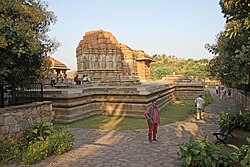Nagda
Nag-dah | |
|---|---|
Historical Place | |
 | |
   | |
| Country | India |
| State | Rajasthan |
| District | Udaipur District |
| Established | 7th century AD |
| Founded by | King Nagaditya |
Nagda is a village in Udaipur district of Rajasthan state in India.[1] It was once a prominent city in the early Mewar state. Today it is known primarily for the remains of the Sahasra Bahu Temples.
Location[edit]
Nagda is situated approximately 20 kilometers north of Udaipur or 2.5 km away from Eklingji, another sacred area.
History[edit]
Nagda was probably established by King Nagaditya of the Guhil dynasty in the 7th century AD and it was known as Nagahrada then.[2] Nagda was the first capital of Mewar and continued to be so until c. 948 when the capital was shifted to Ahar.[3] In c.1116, Nagda again became the capital of Mewar and stayed so until the early part of the 13th century when it was sacked by Sultan Iltutmish's forces.[2]
Population[edit]
The population of Nagda is 237.[1]
References[edit]
- ^ a b "District Census Handbook Udaipur, Village and Town Wise Primary Census Abstract Part XII-B". Census2011.co.in. 2011. Retrieved 30 September 2011.
- ^ a b Jain, Kailash Chand (1972). Ancient Cities and Towns of Rajasthan, A Study of Culture and Civilization. Motilal Banarsidass. pp. 213–219.
- ^ Bhattacharya, A.N. (2000). Human Geography of Mewar. Himanshu Publications. ISBN 9788186231906.
23°27′23″N 75°24′47″E / 23.4564°N 75.4131°E
Well, that’s interesting to know that Psilotum nudum are known as whisk ferns. Psilotum nudum is the commoner species of the two. While the P. flaccidum is a rare species and is found in the tropical islands. Both the species are usually epiphytic in habit and grow upon tree ferns. These species may also be terrestrial and grow in humus or in the crevices of the rocks.
View the detailed Guide of Psilotum nudum: Detailed Study Of Psilotum Nudum (Whisk Fern), Classification, Anatomy, Reproduction